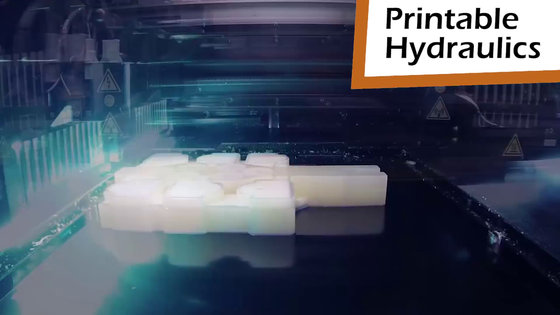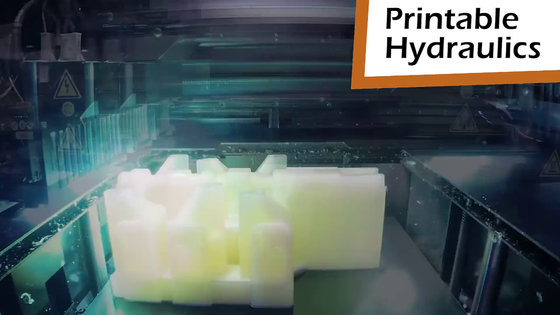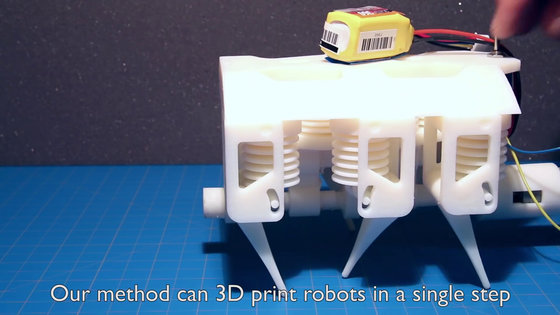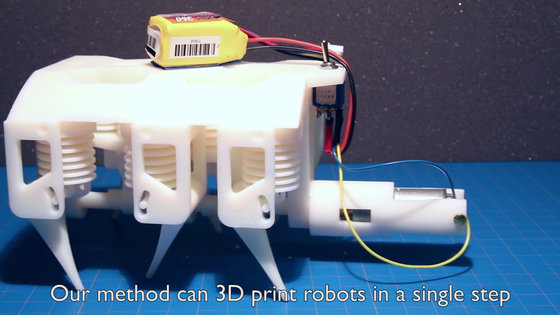Robots that do not need to be assembled are output as solids and liquids from 3D printers

Speaking of the robot, it imagines a complex mechanism combining a number of small parts, but almost all parts such as legs, hydraulic pumps, crankshafts etc. necessary for the mechanism of the robot are assembled as a robot and one The Massachusetts Institute of Technology (MIT) has announced a marvelous technology to be output from 3D printers.
First-ever 3-D printed robots made of both solids and liquids | MIT News
http://news.mit.edu/2016/first-3d-printed-robots-made-of-both-solids-and-liquids-0406
Many robots are being developed in the world, but "robots that give advice etc. while flying around the hero" that appears in cartoons and games has not appeared today. One of the reasons for this is that it is very difficult to assemble a robot, and media that disseminates research results etc. in MIT to the outsideMIT NewsI will talk.
It is obvious that it takes a lot of time if you try to assemble a robot with the hand of a human being, it is obvious that even if you want to make a robot in a robot by automating the assembly work, you can make a robot I heard that adjustment can not be done enough yet. So, "Researchers at MIT's Computer Science & Artificial Intelligence Laboratory (CSAIL) who thought that it would be a 3D printer if it says" It takes time and labor for humans and robots to take too much time ", can output liquid and solid at the same time We have developed a 3D printer and published a paper on how to create a "robot that does not need to be assembled" using it.
Daniela Rus, a researcher at CSAIL and one of the authors of the paper, says, "The approach we call" outputable hydraulic system "is a major step that will allow you to quickly assemble functional machines. The only thing we need to do is just install the battery and the motor, so we can make a robot that can walk around quickly with a 3D printer. "
The state that the "robot that does not need to be assembled" which is actually told in the paper is outputted by the 3D printer and moves around can be seen in the following movie.
Printable Hydraulic Robots - YouTube
Something is being output with a 3D printer.


A robot equipped with six legs and twelve hydraulic pumps was output. Push the attached switch and ......

The robot started walking automatically. This robot is a motor and a battery attached by human's hands but the others are all "3D robots that do not need to be assembled" which only 3D printers output.

"Robots that do not need to be assembled mostly" are made of materials such as hardness and solid / liquid such as liquid (blue), hard solid (green), soft solid (yellow green), support (yellow) It outputs it separately.

For example this is a hydraulic gear pump.

Until now, if we tried to output a gear pump with a 3D printer, it was necessary to output and assemble several parts, but if it was the method invented by MIT, it will output a gear pump that can be used immediately with a 3D printer.

The following is an actuator for transmitting power to the robot to the leg. The interior is hollow, so if one is pushed, one side will become stretched, which can also be output as it is with a 3D printer.


The crankshaft that transmits the power of the hydraulic pump to the leg is like this.

It is the point of this paper that robot assembly is dramatically easier because all these parts can be output without having to assemble them all.

In addition, it is possible to operate the robot from the smartphone by attaching a substrate etc. to the motor.

In this research, using flexible materials and liquid ... ...

Arms that operate by pushing the pump as follows are also output.


Applying this is like this. A black colored U shaped arm was output by a 3D printer.

It closes quietly and grasps the head of a duck ... ...

Succeeded to lift as it is.

Liquid output in 3D printing technology lacks accuracy more than others. So, in order to accurately output the liquid, it was necessary to dissolve the output once outputted or to cleanly clean the part to put the liquid with human hands. Since these are labor-intensive methods, it was impossible to create motion systems that used liquids until factory level scale. In this research, we output liquid by outputting liquid which solidifies with ultraviolet light and different material for each layer.
Desktop size 3D printer market of less than 5000 dollars (about 540,000 yen) is growing rapidly, independent consultantWohlers AssociatesAccording to the survey, it is clear that in 2015 278,000 3D printers were sold. With this condition, if 3D printers are spreading explosively, it may well happen that "output robots with home 3D printers" can occur.

Related Posts:







